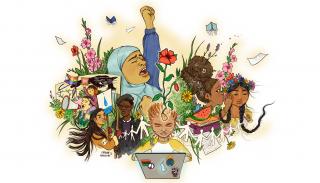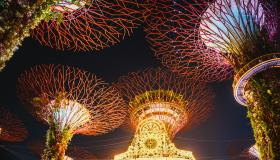
Breadcrumbs navigation
Secular(ised) Christmas in Singapore and the Everyday (re)Production of Modernity/Coloniality
In this blog post, Yu Depeng, from the National University of Singapore, analyses Christmas as a modern subject that is both religious and secular, and highlights the importance of further incorporating the study of everyday religions and secularism in examining the reproduction of modernity/coloniality.

I was sitting in a cafe at the entrance to Singapore’s National University Hospital (NUH) main building on a weekday afternoon. Although this was early November, the Christmas celebration/promotion had already begun: coffee cups in red and white with decorative snowflakes and wreaths; Santa flying around on the menu screen; people discussing how this year’s Christmas mugs were better-designed than last year’s. It feels bizarre how Christmas demands so much preparation and attention in Singapore. Isn’t Christmas a religious festival commemorating the birth of Jesus Christ? Then, why is it celebrated worldwide in the way it is, including in regions with little Christian presence and across social groups? Thinking from Singapore, I argue that Christmas today - both a secular(ised) and religious festival - is symptomatic and constitutive of capitalist modernity/coloniality in Singapore.
The aforementioned cafe was full of Christmas products: from gingerbread man cookies to a Christmas special latte. Ironically, in a tropical climate with no winter season, coffee mugs were decorated with reindeer, white snow, and Santa. Despite their common allusions to (a western version of) Christianity, they share the same purpose: to be sold. Here, two customers were discussing whether the patterns on the mugs would fit the shelves they have at home. It seems like the purpose of such Christmas objects is not religious for them, but consumerist. The mugs are not purchased for spiritual blessings, but rather to create a festive vibe. This is not a ‘religious’ act in a traditional sense of the term. Intriguingly, the cafe’s promotion board display screen had a large ‘Enchanting Holiday’ displayed. Yet, surely, this does not imply that the cafe is a site, or that its products are objects, of religious or biblical enchantment - surely not in the sense of acting against modernity’s disenchantment. Rather, this is to promote consumption - a marketing strategy. If there was any religion at play, it was the religion of consumerism and capitalism (McCarraher, 2019).
Indeed, the commercialisation of Christmas is key to understanding its complex contemporary workings in a place like Singapore. Its economic contributions are often raised as its most important and central raison d’etre within the modern capitalistic nation-state. As a secular(ised) festival, it offers a prime example of ‘the re-articulation of religion in a manner that is commensurate with modern sensibilities and modes of governance’ (Mahmood 2009: 59). But there is more here than just capitalism. Indeed, Christmas’ secular performance in modern Singapore is intriguing. What does it mean to have Christmas as a secular festival, or better phrased, secularised festival? What are the conditions of possibility, and what does this enact in the world? Here, I propose to analyse this through a contrast to other festivals that remain ‘religious’ in contemporary Singapore. In thinking through this, I want to specifically turn to a comparison between Deepavali and Christmas.
Back to the cafe. As I finished my last sip of coffee, I stepped out and saw the LED screen on the wall of the main building of NUH - ‘Happy Deepavali!’ Some modest decorations were there, without much zest nor pomp. Deepavali is in 3 days. I was struck by the stark contrast. In Singapore, Christmas is a festival that everyone, regardless of race and religion, can and mostly do enjoy. Deepavali, on the other hand, is associated with Indians only, or as Singaporeans put it, is a Hindu festival. This is despite the fact that many non-Hindu Indians including Muslims also celebrate it.
The differential treatment of Deepavali and Christmas in modern Singapore is a good site to take a closer look into the logic of modernity/secularity/coloniality (Lloyd & Viefhues-Bailey, 2015; Vizcaino 2020). Deepavali’s status as a Hindu religious festival is a historical legacy of colonisation in which race and religion were invented and entwined as modern categories and then conflated under the governance of colonial powers. As Maldonado-Torres (2014: 693) posits, the modern concepts of race and religion are intimately linked and they ‘play a key role in the formation of modernity/coloniality’. Hence, under the governance of modernity, to call Deepavali a Hindu festival is to race it as an Indian festival; celebrating it is a religious act specific to a particular race. Yet, this logic does not seem to apply to Christmas.
This contradiction can be analytically understood through Wytner’s (1995) interpretation of Du Bois’ concept of the ‘colour line’ as a modern conceptualisation of human difference. The ‘colour line’ is based on a binary logic that runs through the blood of modern systems of representation. This ‘colour line’ was drawn between the ‘white’ and the ‘black’, positioning the white in humanity and the black in sub-humanity or even non-humanity. Similarly, in contemporary Singapore, the ‘secular line’ has been drawn between Christmas and Deepavali imagining Christmas as a (white) secular festival and Deepavali as a religious one. This is not a critique of the universalisation of Christmas per se, but a making visible of its relation to power. Today, a public perception that only Westernised Christian festivals such as Christmas can merge with modernity and capitalism reigns hegemonic. Christmas has been successfully uprooted from its so-called degraded religious soil and put into a well-oiled secular machine. It drives a capitalistic economy, brings progress, and builds (westernised) modernity. On the other hand, festivals such as Deepavali are bound to their religious roots, and shoulder the burden of racial heaviness, with their mobility in any direction paralysed. In other words, Deepavali, as well as other religious festivals such as Muslim Hari Raya, remain largely excluded within the wider structures of Eurocentric Modernity.
The modern myth is that all ‘religions’ are equal. Christmas in the Asian metropolis of Singapore speaks otherwise. Only Christmas can dress up and perform secularly while other religious festivals cannot. The hierarchisation of religions still lives on, manifesting differently: the hierarchisation of festivals. This is a modern contradiction produced by the world system and built on the ‘colour line’, ‘secular line’, and whichever classificatory institution is in place. Such systems serve ‘as a blueprint of the ongoing division of humankind’ (Gordon, 2000: 266).
The division of humans and human activities is not innocent. It has great implications on lived experiences. Sinha (2016) shows how religious communities in Singapore have to fight for urban public spaces to perform religious activities. McCallum (2017) makes visible how the British colonial government constructed the idea of the ‘noisy natives’ which shaped noise management in the city-state resulting in its suppression of local social and religious activities. The modern Singapore government carries these (sonic) legacies of its former coloniser, including prohibitions on the outward projection of Muslim calls for prayer in many urban sites. Within this, public spaces here do not only refer to the physicality of a piece of land but to a larger possibility of being.
The issue is not the ‘competition’ between different religious festivals in fighting for urban presence or a right to the city. Rather, it is how Christmas swaggers in the corridor of ‘bureaucracy’ opening onto urban spaces without knocking. In my years in Singapore, I never encountered anyone saying that Christmas songs played in shopping malls are offensive, but I have heard many complain about how ‘Indian music’ played in Little India during Deepavali is experienced as aggressive and chaos-inducing. Music played in any and every mall for Christmas is appropriate, yet music played in a particular area for the ‘Hindu festival’ is a nuisance. If we follow the proclaimed modern neoliberal logic that ‘religion is confined to the heart, treated as a personal choice’ (Lloyd, 2017: 4) under a clear demarcation between public/secular space and private/religious space, then this would seem to pose a dilemma. Why are there expanding public spaces for Christmas celebrations? My argument is that this cannot be understood without understanding the contemporary Asian workings of modernity/coloniality and its everyday reproduction. Labelling Christmas as modern and ‘secular’ grants it the right to colonise public-always-secular(ised) spaces. Imprisoning Deepavali in the religious prevents it from entering those spaces. Therefore, ‘religion’ is surely no ‘private matter’.
This post analyses Christmas as a modern subject that is both religious and secular. The analysis is built on the secularisation of Christmas in Singapore in its entwinement with Eurocentric modernity and capitalism. From there, it problematizes the secularisation of Christmas by drawing comparisons with Deepavali - a festival which remains religious and has become highly racialised. It ultimately raises the problematics of differential treatment and their implications: namely the hierarchisation of festivals (and religions) in contemporary Singapore, and the wider globe. By doing this, it highlights the importance of further incorporating the study of everyday religions and secularism in examining the reproduction of modernity/coloniality.
References
-
Du Bois, W. E. B. (1990). The souls of black folk (1st Vintage Books/Library of America). Vintage Books/Library of America.
-
Gordon, L. R. (2000). Du Bois's humanistic philosophy of human sciences. The Annals of the American Academy of Political and Social Science, 568(1), 265-280.
-
Lloyd, V. W., & Viefhues-Bailey, L. (2015). Introduction: Is the postcolonial postsecular?. Critical Research on Religion, 3(1), 13-24.
-
Lloyd, V. W. (2017). Religion of the Field Negro: On Black Secularism and Black Theology. Fordham Univ Press.
-
Mahmood, S. (2009). Religious reason and secular affect: An incommensurable divide? Critical inquiry, 35(4), 836-862.
-
Maldonado‐Torres, N. (2014). Race, religion, and ethics in the modern/colonial world. Journal of Religious Ethics, 42(4), 691-711.
-
McCallum, J. (2017). Conflict and compromise over processional sound in 19th-century Singapore. Indonesia and the Malay World, 45(133), 315-333.
-
McCarraher, E. (2019). The enchantments of mammon: how capitalism became the religion of modernity. Harvard University Press.
-
Sinha, V. (2016). Marking spaces as ‘sacred’: Infusing Singapore’s urban landscape with sacrality. International Sociology, 31(4), 467-488.
-
Vizcaino, R. (2020). Decolonial responses to secularism from the underside of modernity (Order No. 27743038). Available from ProQuest Dissertations & Theses Global. (2430955740).
-
Wynter, S. (1995). 1492: A New World View. In Race, Discourse and the Origin of the Americas edited by Hyatt, Vera Lawrence, and Rex Nettleford, 5-57. Washington, DC, and London: Smithsonian Institution Press, 302 pp., Publication Date: March 1996. History (Washington)